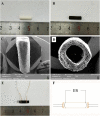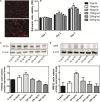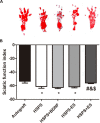Conductive Hydroxyethyl Cellulose/Soy Protein Isolate/Polyaniline Conduits for Enhancing Peripheral Nerve Regeneration via Electrical Stimulation
- PMID: 32719783
- PMCID: PMC7347754
- DOI: 10.3389/fbioe.2020.00709
Conductive Hydroxyethyl Cellulose/Soy Protein Isolate/Polyaniline Conduits for Enhancing Peripheral Nerve Regeneration via Electrical Stimulation
Abstract
Nerve regeneration remains a challenge to the treatment of peripheral nerve injury. Electrical stimulation (ES) is an assistant treatment to enhance recovery from peripheral nerve injury. A conductive nerve guide conduit was prepared from hydroxyethyl cellulose (HEC)/soy protein isolate (SPI)/PANI sponge (HSPS) and then the HSPS conduits were used to repair 10 mm sciatic nerve injury in rat model with or without ES, using HSPS+brain-derived neurotrophic factor (BDNF) and autografts as controls. The nerve repairing capacities were evaluated by animal experiments of behavioristics, electrophysiology, toluidine blue staining, and transmission electron microscopy (TEM) in the regenerated nerves. The results revealed that the nerve regeneration efficiency of HSPS conduits with ES (HSPS+ES) group was the best among the conduit groups but slightly lower than that of autografts group. HSPS+ES group even exhibited notably increased in the BDNF expression of regenerated nerve tissues, which was also confirmed through in vitro experiments that exogenous BDNF could promote Schwann cells proliferation and MBP protein expression. As a result, this work provided a strategy to repair nerve defect using conductive HSPS as nerve guide conduit and using ES as an extrinsic physical cue to promote the expression of endogenous BDNF.
Keywords: electrical stimulation; hydroxyethyl cellulose; peripheral nerve injury; polyaniline; soy protein isolate.
Copyright © 2020 Wu, Zhao, Chen, Xiao, Du, Dong, Ke, Liang, Zhou and Chen.
Figures









Similar articles
-
Comprehensive strategy of conduit guidance combined with VEGF producing Schwann cells accelerates peripheral nerve repair.Bioact Mater. 2021 Mar 21;6(10):3515-3527. doi: 10.1016/j.bioactmat.2021.03.020. eCollection 2021 Oct. Bioact Mater. 2021. PMID: 33842738 Free PMC article.
-
Brain Derived Neurotrophic Factor and Glial Cell Line-Derived Neurotrophic Factor-Transfected Bone Mesenchymal Stem Cells for the Repair of Periphery Nerve Injury.Front Bioeng Biotechnol. 2020 Jul 30;8:874. doi: 10.3389/fbioe.2020.00874. eCollection 2020. Front Bioeng Biotechnol. 2020. PMID: 32850732 Free PMC article.
-
Electrical stimulation enhances sciatic nerve regeneration using a silk-based conductive scaffold beyond traditional nerve guide conduits.Sci Rep. 2024 Jul 2;14(1):15196. doi: 10.1038/s41598-024-65286-9. Sci Rep. 2024. PMID: 38956215 Free PMC article.
-
Peripheral nerve injury repair by electrical stimulation combined with graphene-based scaffolds.Front Bioeng Biotechnol. 2024 Feb 28;12:1345163. doi: 10.3389/fbioe.2024.1345163. eCollection 2024. Front Bioeng Biotechnol. 2024. PMID: 38481574 Free PMC article. Review.
-
Advances in Large Gap Peripheral Nerve Injury Repair and Regeneration with Bridging Nerve Guidance Conduits.Macromol Biosci. 2023 Oct;23(10):e2300078. doi: 10.1002/mabi.202300078. Epub 2023 Jun 14. Macromol Biosci. 2023. PMID: 37235853 Review.
Cited by
-
Comprehensive strategy of conduit guidance combined with VEGF producing Schwann cells accelerates peripheral nerve repair.Bioact Mater. 2021 Mar 21;6(10):3515-3527. doi: 10.1016/j.bioactmat.2021.03.020. eCollection 2021 Oct. Bioact Mater. 2021. PMID: 33842738 Free PMC article.
-
Enhanced peripheral nerve regeneration by mechano-electrical stimulation.NPJ Regen Med. 2023 Oct 17;8(1):57. doi: 10.1038/s41536-023-00334-y. NPJ Regen Med. 2023. PMID: 37848428 Free PMC article.
-
Biohacking Nerve Repair: Novel Biomaterials, Local Drug Delivery, Electrical Stimulation, and Allografts to Aid Surgical Repair.Bioengineering (Basel). 2024 Jul 31;11(8):776. doi: 10.3390/bioengineering11080776. Bioengineering (Basel). 2024. PMID: 39199733 Free PMC article. Review.
-
3D Printed Personalized Nerve Guide Conduits for Precision Repair of Peripheral Nerve Defects.Adv Sci (Weinh). 2022 Apr;9(12):e2103875. doi: 10.1002/advs.202103875. Epub 2022 Feb 18. Adv Sci (Weinh). 2022. PMID: 35182046 Free PMC article. Review.
-
Brain Derived Neurotrophic Factor and Glial Cell Line-Derived Neurotrophic Factor-Transfected Bone Mesenchymal Stem Cells for the Repair of Periphery Nerve Injury.Front Bioeng Biotechnol. 2020 Jul 30;8:874. doi: 10.3389/fbioe.2020.00874. eCollection 2020. Front Bioeng Biotechnol. 2020. PMID: 32850732 Free PMC article.
References
-
- Arteshi Y., Aghanejad A., Davaran S., Omidi Y. (2018). Biocompatible and electroconductive polyaniline-based biomaterials for electrical stimulation. Eur. Polymer J. 108 150–170. 10.1016/j.eurpolymj.2018.08.036 - DOI
-
- Chen Y., Ke C., Chen C., Lin J. (2018). “Effects of acupuncture on peripheral nerve regeneration,” in Experimental Acupuncturology, ed. Lin J. G. (Singapore: Springer; ), 81–94. 10.1007/978-981-13-0971-7_6 - DOI
LinkOut - more resources
Full Text Sources
Research Materials
Miscellaneous

